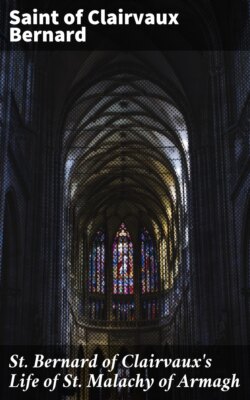St. Bernard of Clairvaux's Life of St. Malachy of Armagh

Реклама. ООО «ЛитРес», ИНН: 7719571260.
Оглавление
Saint of Clairvaux Bernard. St. Bernard of Clairvaux's Life of St. Malachy of Armagh
St. Bernard of Clairvaux's Life of St. Malachy of Armagh
Table of Contents
PRINCIPAL AUTHORITIES REFERRED TO
NAMES OF IRISH PERSONS AND PLACES
INTRODUCTION
THE LIFE OF ST. MALACHY
PREFACE
Here begins the life of Malachy the Bishop
CHAPTER I
CHAPTER II
CHAPTER III
CHAPTER IV
CHAPTER V
CHAPTER VI
CHAPTER VII
CHAPTER VIII
LETTERS OF ST. BERNARD
SERMONS OF ST. BERNARD ON THE PASSING OF MALACHY
ADDITIONAL NOTES
APPENDIX
INDEX
Отрывок из книги
Saint of Clairvaux Bernard
Published by Good Press, 2019
.....
That such a movement actually took place in the twelfth century is beyond doubt. From about the year 1200 on it is certain that the organization of the Church of Ireland was similar to that of the other Churches of western Christendom. The country was divided into dioceses; and each diocese had a bishop as its ruler, and a Cathedral Church in which the bishop's stool was placed. The Cathedral Church, moreover, had a chapter of clergy, regular or secular, who performed important functions in the diocese. But up to the end of the eleventh century all these things were unknown among the Irish. The constitution of the Church was then of an entirely different type, one that had no exact parallel elsewhere. The passage from the older to the newer organization must have taken place in the twelfth century. During that century, therefore, there was a Reformation in the Irish Church, however little we may know of its causes or its process. But this Reformation was no mere re-modelling of the hierarchy. It can be shown that it imposed on the members of the Church a new standard of sexual morality; if we believe contemporary writers, it restored to their proper place such rites as Confession, Confirmation and Matrimony; it substituted for the offices of divine service previously in use those of the Roman Church; it introduced the custom of paying tithes; it established in Ireland the monastic orders of Latin Christendom1; and it may have produced changes in other directions.2 But I propose to confine myself to the change in the constitution of the Church, which was its most striking feature. The subject, even thus narrowed, will give us more than can be satisfactorily treated in a few pages.
First, I must emphasize the assertion made a moment ago that the constitution of the Irish Church in the eleventh century was sui generis. Let us begin by reminding ourselves what it was from the sixth to the eighth century. It was then essentially monastic in character. The rulers of the Church were the abbots of the monasteries, commonly known as the coarbs or successors of their founders. These abbots were sometimes bishops; but whether they were bishops or of lower rank in the ministry, their authority was inherent in their office of coarb. At this period bishops were numerous—more numerous than in later medieval or modern times; and certain functions were reserved for bishops, for example, ordination. No ecclesiastic, of whatever status, could perform such functions, unless he was of the episcopal order. But no bishop, as such, had jurisdiction. The bishops were often subordinate officers in monasteries, reverenced because of their office, but executing their special functions at the command of the abbots. Sometimes a bishop was attached to a single tribe. Sometimes a group of bishops—often seven in number—dwelt together in one place. But in no case, I repeat, had they jurisdiction. Thus ecclesiastical authority was vested in the abbots. The episcopate was bestowed on certain individuals as a personal distinction. Thus the bishops, if they were not also abbots, had only such influence on the affairs of the Church as their sanctity, or their learning, might give them.
.....